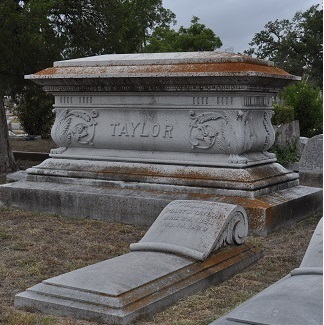
Image Credit:
Lindsey Gay
I can remember taking only one field trip after I left the K-12 system. Between three universities in my undergraduate and graduate career, only one lone little undergrad geology course featured an off-site learning experience as a standard part of the curriculum. Therefore, when I realized that I had the chance to take my own RHE 309K students on a field trip, I jumped at the opportunity.
Some background: I am teaching The Rhetoric of Death and Dying, a class which combines the analysis of public discourses about death with cultural and personal study. The past few weeks have comprised our unit on rhetorical analysis, and just prior to the field trip the students had been preparing for a group presentation analyzing a notable public memorial somewhere in the world. I knew when I developed the course that I wanted to combine analysis of a large-scale public memorial with analysis of small-scale private memorials, so I planned on taking my students to Austin’s Oakwood Cemetery. Oakwood is one of the oldest public cemeteries in Austin, with gravesites dating from the 1840s. It is also conveniently adjacent to east campus. My class period is also 75 minutes, which was a good length of time in which to accomplish this trip.
My students were very excited about the field trip, but I quickly found that this trip would be as much about learning how to be a responsible citizen in the world as it would be about the arguments that tombstones and cemeteries make. The week before our trip, I polled the class to see how many students had ever actually been to a cemetery. Only about half raised their hands, and of those most said they had just gone for a graveside service and had not walked elsewhere in the cemetery. They essentially had no practical experience of how to conduct themselves in such a space. We talked about constructing the ethos of a mourner as opposed to a visitor, and what it meant to maintain a respectful vocal volume and physical presence in a cemetery.
The other thing that most of my students had no experience with was taking the city bus. There is a bus stop near to our classroom on campus that takes riders directly to the cemetery in a mere 7 minutes, so I encouraged my students to take the bus with me rather than drive their own cars. When I mentioned in class that Capital Metro bus service is free for students, there were a lot of open mouths! I described how swipe one’s student ID in the payment station on the bus, and how to follow bus etiquette about not hogging two seats to yourself. I sent out an email with information about which stop and when we should meet and which bus we should take, and about half of my students (10 out of 21), accompanied me on the bus. Afterwards, the same group caught the same bus back to campus. I noticed that some of those who rode the bus with me were the same ones who expressed concerns about never having used a city bus system before, so I was glad that they stepped out of their comfort zone into this real-world activity.
At the cemetery, students split into assigned groups and I gave everyone a Cemetery Scavenger Hunt worksheet I created. I wanted this assignment to be about more than just finding interesting things at the cemetery, so I designed the worksheetto reflect on the types of arguments students found on tombstones and in the general situation of the cemetery and its parts. While I wandered on my own taking pictures of the groups and the cemetery, I kept an eye on my students and checked in with each group every now and again. Everyone was working their way through the scavenger hunt; no one littered, engaged in horseplay, or moved any personal objects lefts at gravesites; every group I checked in with had their own favorite tombstone or family plot. They enjoyed speculating on the histories of some of the families buried in Oakwood and hypothesizing why some grave markers were so much smaller and closer together than others. When they saw the stark difference between the white section of the cemetery versus the “colored” grounds, they discussed what arguments were created by the lack of durable gravestones and non-central placement of that section of the cemetery.
Overall, my first foray into fieldtripping was a success. I wanted my students to interact with rhetoric in the real world and on a smaller, more intimate scale than indicated by their group projects. They considered not only the written rhetoric of epitaphs and inscriptions and the visual rhetoric of common figures and images carved into the stones, but also the rhetoric of experience. Walking around a quiet, grassy, semi-wooded space filled with other people’s memories creates a rhetorical situation in and of itself. I was glad not to lose track of anyone in the cemetery or on the bus, and it turned out to be a good lesson for everyone in rhetoric, planning, responsibility, and appropriate behavior. Learning does indeed continue outside of the classroom.

